The following photos are held a Princeton University webserver. They appear to have run some sort of competition for the best science related photos and have done so for 2010, 2009, 2006 & 2005. Don't ask me what happened to the other years.
Here are the three winners. Click on the images to read about how they were created. Much of the details bellow are in deed paraphrased as i understand very little of it.
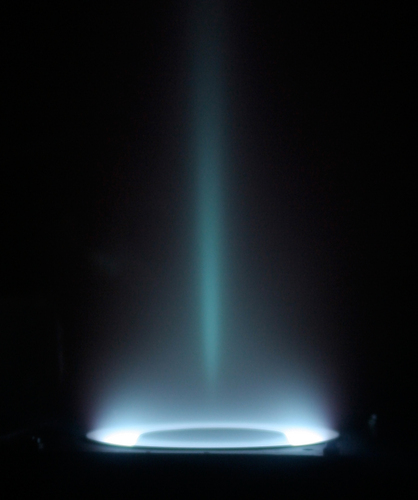 This Xenon Plasma Accelerator uses electronic and magnetic fields to accelerate xenon propellant to produce thrust. Xenon is a colourless gas but we can see a blue haze here due to the result of the xenon being excited by electric discharge - like the blue zap of static electric shock we're all too familiar with, although this is a form of electrostatic discharge, but you get the idea. Plasma Accelerators are a leading technology for future space flight... and it looks darn pretty too.
This Xenon Plasma Accelerator uses electronic and magnetic fields to accelerate xenon propellant to produce thrust. Xenon is a colourless gas but we can see a blue haze here due to the result of the xenon being excited by electric discharge - like the blue zap of static electric shock we're all too familiar with, although this is a form of electrostatic discharge, but you get the idea. Plasma Accelerators are a leading technology for future space flight... and it looks darn pretty too.Credits:Jerry Ross (fac) - PPPL
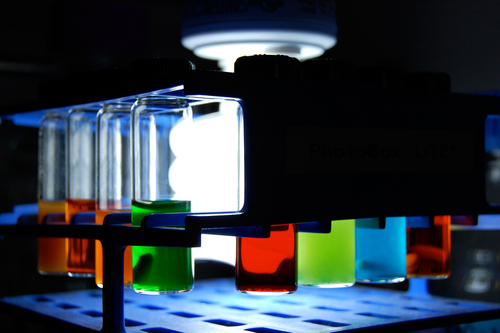 This submission depicts an experimental investigation employing an energy-saving compact fluorescent light bulb to excite a variety of coloured photocatalysts. I can't say too much more about it because i don't understand it. But if you want to know more, click on the image to see the larger picture and see what the people behind the picture had to say.
This submission depicts an experimental investigation employing an energy-saving compact fluorescent light bulb to excite a variety of coloured photocatalysts. I can't say too much more about it because i don't understand it. But if you want to know more, click on the image to see the larger picture and see what the people behind the picture had to say.Credits: David Nagib (GS), Department of Chemistry
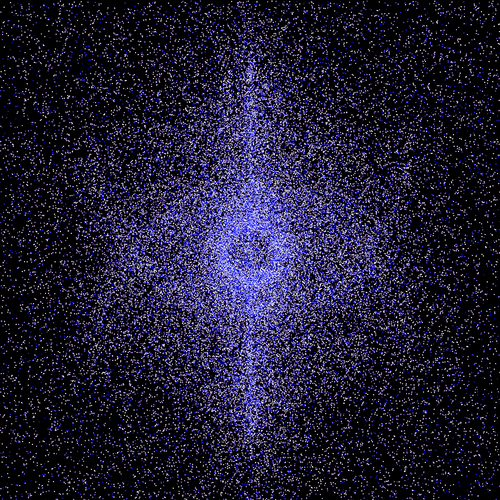 Dense star environments can cause amazingly intricate patterns as is seen in this picture. Eventually, most of the stars escape the galaxy, leaving a less dense cluster that can interact with the central black hole in low-eccentricity orbits.. but until that happens, stars will group in common orbits. What we see here are groups of stars clumping together in three distinct common orbits. Two orbits form the eye shape, the third slices right through the middle which we see only from the side.
Dense star environments can cause amazingly intricate patterns as is seen in this picture. Eventually, most of the stars escape the galaxy, leaving a less dense cluster that can interact with the central black hole in low-eccentricity orbits.. but until that happens, stars will group in common orbits. What we see here are groups of stars clumping together in three distinct common orbits. Two orbits form the eye shape, the third slices right through the middle which we see only from the side.Credits: Tim Koby '11 - Department of Physics
Here are my favourites, not including the winners above. You may also click on the images to read how they were created.
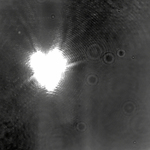 This is my favourite by far! The heart-shaped light seen here is the result of an attempt by Nick Bax of the Department of Chemistry to create an "optical trap," a tightly focused laser beam of light capable of holding microscopic particles stable in three dimensions. Unfortunately for Nick, but very fortunate for us, after a day of trouble shooting, this was as round as the beam would form. The circular shapes in the background are a result of the unsuccessfully trapped beads.
This is my favourite by far! The heart-shaped light seen here is the result of an attempt by Nick Bax of the Department of Chemistry to create an "optical trap," a tightly focused laser beam of light capable of holding microscopic particles stable in three dimensions. Unfortunately for Nick, but very fortunate for us, after a day of trouble shooting, this was as round as the beam would form. The circular shapes in the background are a result of the unsuccessfully trapped beads.I feel sorry for Nick. He was unsuccessful in capturing those darn beads, but he created, in my mind, a masterpiece of art! Well done.
Credits: Nick Bax '12 - Department of Chemistry (Photo taken at NIH/NHLBI)
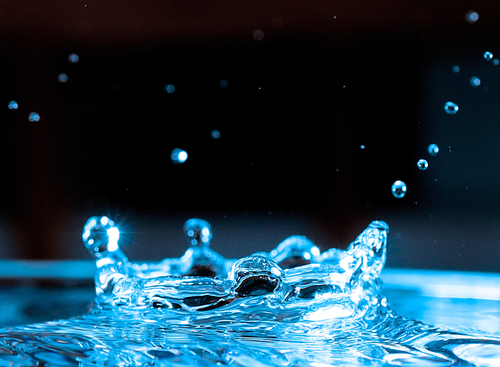 A brief examination of surface tension effects in water lead to this photo, of a drop of water colliding with a water surface. The image was captured just a moment too late, revealing this "crown" of water, rather than the surface tension interaction between the drop and the pool. The image was captured using a 1/100,000s light pulse to capture the precise moment of the behavour of the water.
A brief examination of surface tension effects in water lead to this photo, of a drop of water colliding with a water surface. The image was captured just a moment too late, revealing this "crown" of water, rather than the surface tension interaction between the drop and the pool. The image was captured using a 1/100,000s light pulse to capture the precise moment of the behavour of the water.Credits: David Heinz - Department of Mechanical Engineering
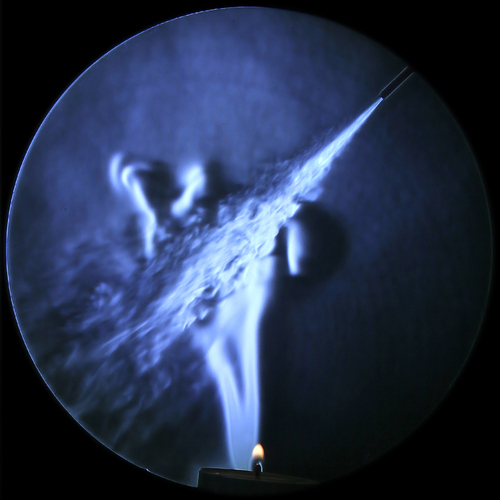 When air changes temperature, it also changes refractive index. So, light rays bend as they pass through hot or cool patches of air. You can common see this on a hot Australian afternoon on black bitumen roads - also know n as a mirage. This is a photo of a jet of cool compressed air (top right) as it passes through the hot air plume above a small candle (bottom).
When air changes temperature, it also changes refractive index. So, light rays bend as they pass through hot or cool patches of air. You can common see this on a hot Australian afternoon on black bitumen roads - also know n as a mirage. This is a photo of a jet of cool compressed air (top right) as it passes through the hot air plume above a small candle (bottom).The technique used to make this photo is called schlieren photography. A small point light source, in this case an LED light covered by a strip of tin foil punctured with a pin, illuminates a concave mirror. Directly in front of the mirror is the hot or cold object, in this case a candle. Light refracts through the candle, strikes the mirror, and is refocused to a point, where the light is partially blocked by the edge of a razor. A camera is placed directly behind the razor. Light that has been refracted to the left or the right appears brighter or darker in the final image, since more or less of the light makes it past the razor edge. This method is used in research to study heat convection, shock waves, sound waves, and other refractive phenomena.
Credits: Steven A Ross '10 - Department of Computer Science
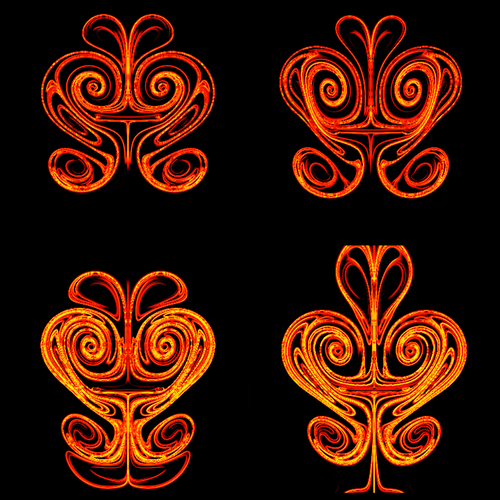 These panels show mixing that takes place when a flat plate moves up and down in an otherwise still fluid. Each face represents the fluid flow field at a different point in time. As the fluid mixes, the facial expressions become more elaborate.
These panels show mixing that takes place when a flat plate moves up and down in an otherwise still fluid. Each face represents the fluid flow field at a different point in time. As the fluid mixes, the facial expressions become more elaborate.Credits: Steve Brunton (GS) - Department of Mechanical & Aerospace Engineering
These are great images, but there are still plenty more to be found in the 2009, 2006 & 2005 Galleries. This is something I will be checking up on next year - If i've stuck by this blogging idea that is. If you find some pictures in the galleries taht particularly appeal to you, I'd love to see them - let me know about it!
No comments:
Post a Comment